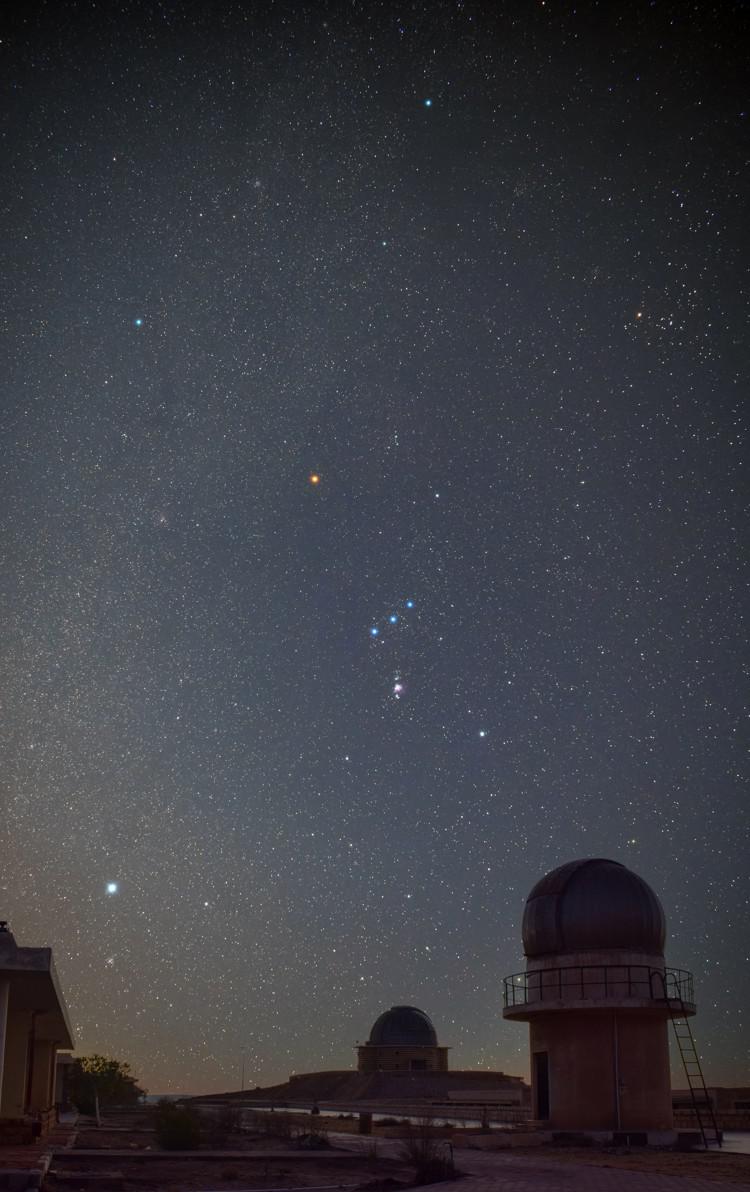This page describes an image Winter Constellations
Caption:
Winner in the 2022 IAU OAE Astrophotography Contest, category Still images of celestial patterns.
Taken from the Kottamia Astronomical Observatory, Cairo, Egypt, in December 2021, this image shows a few prominent winter constellations of the northern sky above the largest telescope in North Africa.
The photograph depicts the constellation of Orion (prominently in the middle of the image) with its belt of stars pointing up to Aldebaran in Taurus and down to Sirius in Canis Major. Aldebaran is a reddish star that we see in front of the open star cluster of the Hyades (at the upper right edge of the image), which is the face of Taurus, the bull. The bright white star is Sirius, the brightest star in the night sky. Its Greek name (Seirios) means “the burner” and can be understood metaphorically as “the brightest”.
This constellation has been represented in a variety of different cultures from all over the world. The ancient Egyptian religion also associates the constellation of Orion with a male figure, namely the god Osiris. It is told that Osiris was murdered by his envious brother Seth, who then dismembered the body and scattered the pieces all over the land. Fortunately, Osiris’s sister-wife Aset (Greek: Isis) is the most powerful sorceress and protective mother goddess. She collected the pieces, put them back together and breathed life back into the god. Aset is seen in the star pattern around the bright star Sirius at the bottom of the photograph. The Egyptian name for Sirius (and adjacent areas) is Sopdet (Greek: Sothis). The heliacal rise of Sirius in summer was a harbinger of the Egyptian new year.
Going north, we can spot a bluish star. This is Alhena, one of the stars in the feet of the zodiacal constellation Gemini, the twins, whose bright head stars would be beyond the upper left edge of the photograph. In the top centre we can see the star Elnath, in the constellation of Auriga, the charioteer. It is associated with Erichthonius, a hero of Greek mythology believed to be the inventor of the four-horse chariot. This same star is also considered the tip of the upper horn of Taurus, the bull. In Greek mythology Taurus is associated with the god Zeus who had sent him to rob a princess. It is commonly known that this Greek story was invented in order to include the Babylonian constellation in Greek mythology. In the Mesopotamian Gilgamesh saga, which is one of the oldest pieces of literature that we know (being traced back to the 3rd millennium), Taurus is the bull of heaven, sent by a jealous goddess and defeated by the king of Uruk to save his people. In the sky it harbours several interesting astronomical objects.
Credit:
Mohamed Aboushelib/IAU OAE
DOI: 10.5281/zenodo.7425288
Related glossary terms:
Color
, Constellation
, Orion
, Taurus
Categories:
Naked Eye Astronomy
, Stars
License: Creative Commons Attribution 4.0 International (CC BY 4.0) Creative Commons Attribution 4.0 International (CC BY 4.0) icons
The media file captions presented on the OAE website were written, translated and reviewed by a collective effort from the OAE, the OAE Centers and Nodes, the OAE National Astronomy Education Coordinators (NAECs) and other volunteers. You can find a full list of credits for our translation project here. All media file captions are released under a Creative Commons CC BY-4.0 license and should be credited to "IAU OAE". The media files themselves may have different licenses (see above) and should be credited as listed above under "credit".
Captions in Different Languages:
Caption: Auszeichnung beim IAU OAE Astrofoto-Wettbewerb 2022, Kategorie Weitwinkelaufnahmen von Himmelsmustern.
Dieses Bild wurde im Dezember 2021 am Kottamia Astronomical Observatory in der Nähe von Kairo in Ägypten aufgenommen und zeigt einige auffällige Wintersternbilder des Nordhimmels über dem größten Teleskop in Nordafrika.
Das Foto zeigt das Sternbild Orion (prominent in der Mitte des Bildes) mit seinem Sternengürtel, der nach oben zu Aldebaran im Stier und nach unten zu Sirius im Großen Hund (lat. Canis Major) zeigt. Aldebaran ist ein rötlicher Stern, der vor dem offenen Sternhaufen der Hyaden (am oberen rechten Bildrand) steht, der das Gesicht des Stiers darstellt. Der helle weiße Stern ist Sirius, der hellste Stern am Nachthimmel. Sein griechischer Name (Seirios) bedeutet "der Brenner" und kann metaphorisch als "der Hellste" verstanden werden.
Dieses Sternbild taucht in einer Vielzahl verschiedener Kulturen auf der ganzen Welt auf. Auch in der altägyptischen Religion wird das Sternbild Orion mit einer männlichen Figur, nämlich dem Gott Osiris, in Verbindung gebracht. Es wird erzählt, dass Osiris von seinem neidischen Bruder Seth ermordet wurde, der daraufhin die Leiche zerstückelte und die Teile über das ganze Land verstreute. Glücklicherweise ist Aset (griechisch: Isis), die Schwester und Ehefrau von Osiris, die mächtigste Zauberin und schützende Muttergöttin. Sie sammelte die Teile ein, setzte sie wieder zusammen und hauchte dem Gott wieder Leben ein. Aset ist durch das Sternenmuster um den hellen Stern Sirius am unteren Rand des Bildes dargestellt. Der ägyptische Name für Sirius (und die angrenzenden Gebiete) ist Sopdet (griechisch: Sothis). Der heliakische Aufgang des Sirius im Sommer war ein Vorbote des ägyptischen Neujahrs.
Weiter nördlich können wir einen bläulichen Stern erkennen. Dabei handelt es sich um Alhena, einen der Sterne, die die Füße des Sternbilds Zwillinge darstellen, dessen helle Hauptsterne sich jenseits des oberen linken Bildrands befinden. Oberhalb der Bildmitte sehen wir den Stern Elnath, im Sternbild Fuhrmann (lat. Auriga). Er wird mit Erichthonius in Verbindung gebracht, einem Helden der griechischen Mythologie, der als Erfinder des vierspännigen Streitwagens gilt. Derselbe Stern gilt auch als die Spitze des oberen Horns vom Stier (lat. Taurus). In der griechischen Mythologie wird der Stier mit dem Gott Zeus in Verbindung gebracht, der ihn geschickt hatte, um eine Prinzessin zu rauben. Man geht davon aus, dass diese griechische Geschichte erfunden wurde, um das babylonische Sternbild in die griechische Mythologie aufzunehmen. In der mesopotamischen Gilgamesch-Sage, die zu den ältesten uns bekannten Werken der Literatur gehört (sie geht bis in das 3. Jahrtausend vor Christus zurück), repräsentiert das Sternbild Stier den Stier des Himmels, der von einer eifersüchtigen Göttin gesandt und vom König von Uruk besiegt wird, um sein Volk zu retten. Am Himmel beherbergt er mehrere interessante astronomische Objekte.
Credit: Mohamed Aboushelib/IAU OAE
Related glossary terms: Farbe , Orion , Sternbild , Stier Caption translation status: Not yet approved by a reviewer
Caption translators: Carolin Liefke
Caption: Vincitore del concorso di astrofotografia IAU OAE 2022, categoria Immagini fisse di modelli celesti.
Scattata dall'Osservatorio astronomico di Kottamia, al Cairo, in Egitto, nel dicembre 2021, questa immagine mostra alcune costellazioni invernali di spicco del cielo settentrionale sopra il più grande telescopio del Nord Africa.
La fotografia ritrae la costellazione di Orione (ben visibile al centro dell'immagine) con la sua cintura di stelle che punta in alto verso Aldebaran nel Toro e in basso verso Sirio nel Cane Maggiore. Aldebaran è una stella rossastra che si vede davanti all'ammasso aperto delle Iadi (in alto a destra nell'immagine), che rappresenta il volto del Toro. La stella bianca e brillante è Sirio, la stella più luminosa del cielo notturno. Il suo nome greco (Seirios) significa "il bruciatore" e può essere inteso metaforicamente come "il più luminoso".
Questa costellazione è stata rappresentata in diverse culture di tutto il mondo. Anche l'antica religione egizia associa la costellazione di Orione a una figura maschile, il dio Osiride. Si racconta che Osiride fu assassinato dall'invidioso fratello Seth, che ne smembrò il corpo e ne sparse i pezzi per tutta la terra. Fortunatamente, la sorella-moglie di Osiride, Aset (in greco Iside), è la più potente maga e dea madre protettiva. Raccolse i pezzi, li rimise insieme e restituì la vita al dio. Aset è visibile nello schema stellare intorno alla stella luminosa Sirio, nella parte inferiore della fotografia. Il nome egizio di Sirio (e delle aree adiacenti) è Sopdet (in greco Sothis). Il sorgere eliaco di Sirio in estate era foriero del nuovo anno egizio.
Andando verso nord, possiamo individuare una stella bluastra. Si tratta di Alhena, una delle stelle ai piedi della costellazione zodiacale dei Gemelli, i gemelli, le cui stelle di testa luminose si trovano oltre il bordo superiore sinistro della fotografia. In alto al centro si vede la stella Elnath, nella costellazione dell'Auriga. È associata a Erittonio, un eroe della mitologia greca ritenuto l'inventore del carro a quattro cavalli. Questa stessa stella è anche considerata la punta del corno superiore del Toro. Nella mitologia greca il Toro è associato al dio Zeus che lo aveva inviato a derubare una principessa. È comunemente noto che questa storia greca è stata inventata per includere la costellazione babilonese nella mitologia greca. Nella saga mesopotamica di Gilgamesh, che è una delle opere letterarie più antiche che conosciamo (si fa risalire al III millennio), il Toro è il toro del cielo, inviato da una dea gelosa e sconfitto dal re di Uruk per salvare il suo popolo. In cielo ospita diversi oggetti astronomici interessanti.
Credit: Mohamed Aboushelib/IAU OAE
Related glossary terms: Colore , Costellazione , Orione , Toro Caption translation status: Not yet approved by a reviewer
Caption translators: Giuliana Giobbi
Caption reviewers: Raffaella Ferretti









